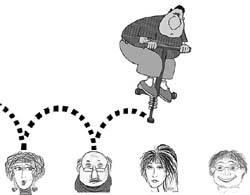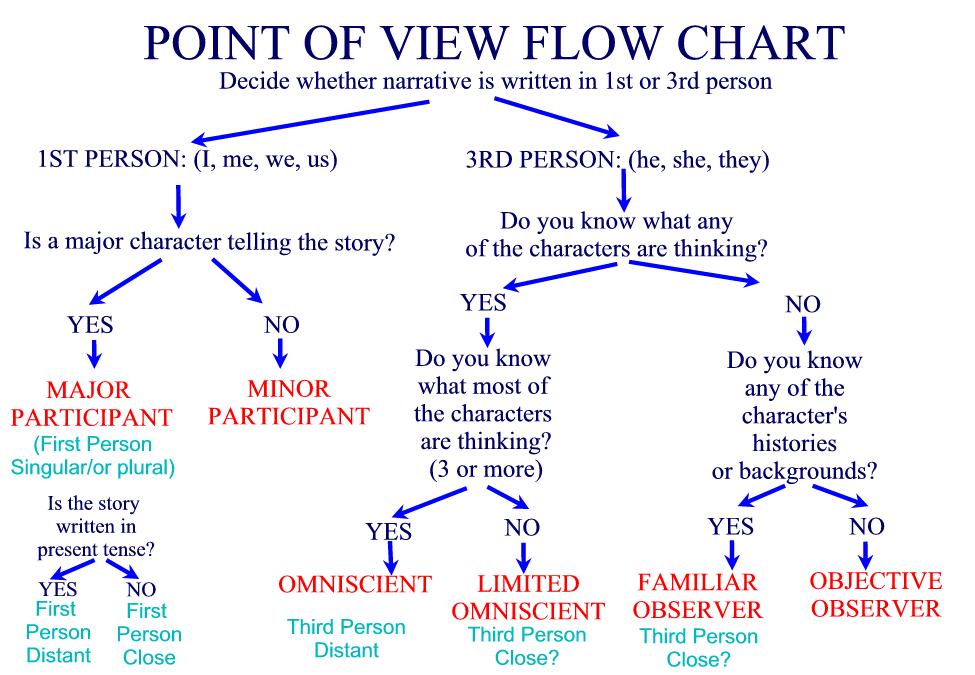 First, let me say that you should write your story any way that you want to. That being said, these are guidelines, not rules carved in stone. Many great authors deviate from these guidelines and create wonderful works. Some readers are okay with head-hopping and some readers detest it. I’m sort of in the middle, but the more I learn about it, the more I lean toward NOT head-hopping in most fiction.
First, let me say that you should write your story any way that you want to. That being said, these are guidelines, not rules carved in stone. Many great authors deviate from these guidelines and create wonderful works. Some readers are okay with head-hopping and some readers detest it. I’m sort of in the middle, but the more I learn about it, the more I lean toward NOT head-hopping in most fiction.
To understand head-hopping, you have to grasp point of view and person.
Most creative fiction is written in first person (I, me, mine, myself, us, our, we) or third person (Proper nouns, like names, and they, he, she) point of view.
With first person, the narrator is often the main character. (But not always, I read a book recently where a doctor was the narrator in first person telling someone else’s story.) This voice allows the reader to identify with the main character very closely. The reader can get inside the head of this person, know what she/he is thinking, and know everything the writer has let the character know. It is limited in that the reader only gets to know his/her feelings and thoughts, not those of the other characters. The writer can describe all of the ways his first person’s character’s five senses are affected, sights, sounds, smells, feelings, tastes, but cannot let you in on what others perceive except second-hand through the first person character.
Joey followed me into the bar. He must not have seen Janet sitting in the booth beside the door. He walked past the booth and ordered a whiskey. Janet blushed at the sight of him so soon after the incident.
In the first paragraph me, the main character, assumes (thinks) that Joey doesn’t see Janet. You are still in the main first person character’s head. The main character, me, sees Janet blush.
Joey followed me into the bar. He didn’t see Janet sitting in the booth by the door. He walked past the booth and ordered a whiskey. Janet felt embarrassed at the sight of him so soon after the incident.
In the second paragraph, there is head-hopping. How does me know Joey didn’t see Janet? He can’t know what Joey thinks. The writer has jumped out of me’s head and into Joey’s head. How does me know what Janet is feeling? The writer has jumped out of me’s head and into Janet’s.
A greater head-hopping problem is when there is head-hopping in the same sentence:
We went into the bar, saw Jane at a booth and she felt embarrassed to see Joey so soon after the incident.
That’s seriously problematic for a reader. The writer is inside three different heads in one sentence.
You can also have multiple POV in first person, usually separated by chapters for ease of reading. It has the effect of slowing the story down to examine each character’s perspective before moving forward, giving the writer’s story an ebb and flow.
With third person, you can have a limited POV (closed omniscient), or unlimited (omniscient).
Third person limited omniscient still restricts feeling and thinking to one central character in a scene. If this was third person omniscient limited (closed to Sam’s POV only) you could write:
Joey followed Sam into the bar. Joey must not have seen Janet sitting at the booth by the door. He walked past the booth and ordered a whiskey. Janet blushed at the sight of him so soon after the incident.
Third person omniscient doesn’t impose those restrictions on the scene. The narrator can show whatever any or all the characters know and feel. If this was third person omniscient you could write:
Joey followed Sam into the bar. Joey did not see Janet sitting at the booth by the door. He walked past the booth and ordered a whiskey. Janet blushed with embarrassment at the sight of him so soon after the incident. She grabbed her purse, arose, and headed for the door.
To totally avoid head-hopping, it is really best, even in third person omniscient POV, to have the thoughts and feelings of different characters separated at least by paragraphs, if not by scenes:
Joey followed Sam into the bar. Joey did not see Janet sitting at the booth by the door. He walked past the booth and ordered a whiskey.
Janet blushed with embarrassment at the sight of him so soon after the incident. She grabbed her purse, arose, and headed for the door.
Many new writers prefer third person omniscient because of the freedom to tell what any character is thinking or feeling, to be able to enter the minds of more than one character. It still has to be done with care, or it comes off terribly confusing.
Separating paragraphs or scenes by POV eases the transition from one head to another.
I want to emphasize that head-hopping is NOT a cardinal sin. There are many experienced writers that use head-hopping very well. Stephen King is one who comes to mind. It has more to do with reader preference and writer technique. It can be done well, or make a read impossible.
Here’s a chart I ran across that breaks POV down for people who follow a visual best:

